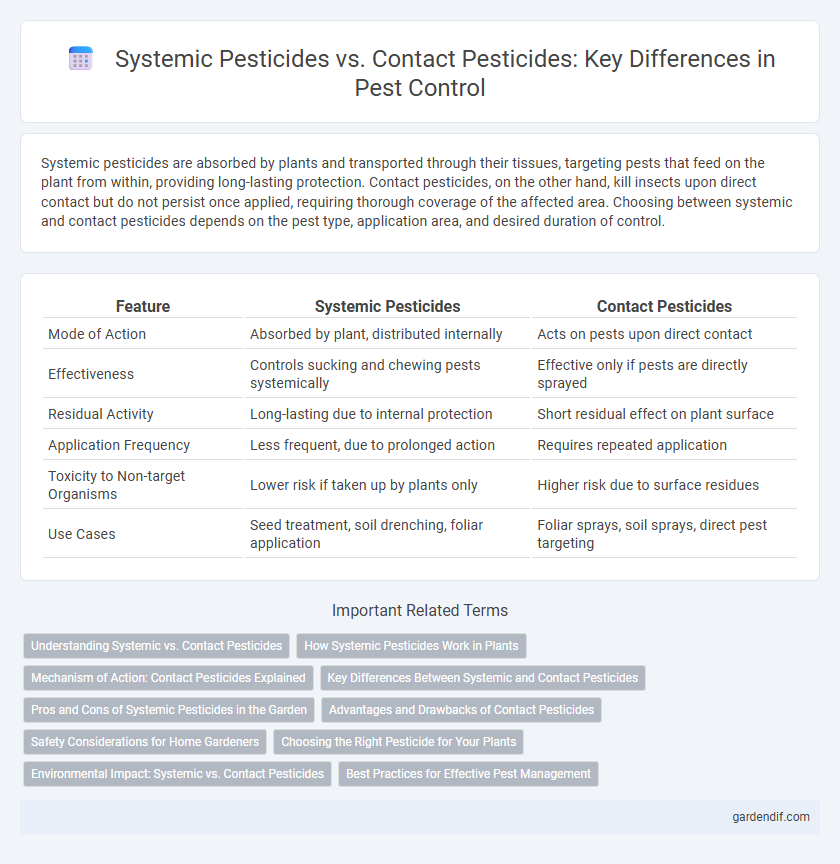
Systemic pesticides vs Contact pesticides Illustration
Systemic pesticides are absorbed by plants and transported through their tissues, targeting pests that feed on the plant from within, providing long-lasting protection. Contact pesticides, on the other hand, kill insects upon direct contact but do not persist once applied, requiring thorough coverage of the affected area. Choosing between systemic and contact pesticides depends on the pest type, application area, and desired duration of control.
Table of Comparison
| Feature | Systemic Pesticides | Contact Pesticides |
|---|---|---|
| Mode of Action | Absorbed by plant, distributed internally | Acts on pests upon direct contact |
| Effectiveness | Controls sucking and chewing pests systemically | Effective only if pests are directly sprayed |
| Residual Activity | Long-lasting due to internal protection | Short residual effect on plant surface |
| Application Frequency | Less frequent, due to prolonged action | Requires repeated application |
| Toxicity to Non-target Organisms | Lower risk if taken up by plants only | Higher risk due to surface residues |
| Use Cases | Seed treatment, soil drenching, foliar application | Foliar sprays, soil sprays, direct pest targeting |
Understanding Systemic vs. Contact Pesticides
Systemic pesticides are absorbed by plants and distributed through their tissues, offering long-lasting protection against pests by targeting insects that feed on the plant internally. Contact pesticides work by directly killing pests upon application, requiring thorough coverage of all pest-infested areas to be effective. Understanding the differences in application methods, persistence, and target pests is essential for effective integrated pest management.
How Systemic Pesticides Work in Plants
Systemic pesticides are absorbed by plants through roots, stems, or leaves and transported via the xylem and phloem to reach internal tissues, providing comprehensive protection against pests. These pesticides target insects feeding on the plant by disrupting vital physiological processes within the pest, ensuring long-lasting pest control. Unlike contact pesticides, systemic pesticides protect new growth and are effective against pests that are difficult to reach or only feed internally.
Mechanism of Action: Contact Pesticides Explained
Contact pesticides operate by directly affecting pests upon exposure, penetrating their outer exoskeleton or surface to disrupt vital biological functions such as nerve signaling or respiratory processes. These pesticides deliver immediate toxic effects, causing rapid incapacitation or death without requiring the pest to ingest treated material. Their efficacy relies on direct contact, making them suitable for controlling pests on plant surfaces or in localized areas where immediate action is necessary.
Key Differences Between Systemic and Contact Pesticides
Systemic pesticides penetrate plant tissues and circulate throughout, targeting pests that feed on internal parts, while contact pesticides remain on the surface and kill pests on direct contact. Systemic pesticides provide longer-lasting protection and are effective against hidden or sucking pests, unlike contact pesticides which require thorough coverage and target only pests exposed on treated surfaces. The choice between systemic and contact pesticides depends on pest type, application method, and desired residual effect.
Pros and Cons of Systemic Pesticides in the Garden
Systemic pesticides offer long-lasting protection by being absorbed into plant tissues, effectively controlling pests over an extended period and reaching areas contact pesticides might miss. However, these pesticides can pose risks to pollinators and beneficial insects due to their presence in pollen and nectar, potentially disrupting garden biodiversity. They also may lead to pest resistance if overused, requiring careful management and targeted application to minimize environmental impact.
Advantages and Drawbacks of Contact Pesticides
Contact pesticides provide immediate pest control by killing insects upon direct application, minimizing residual toxicity in the environment. Their main advantage lies in rapid action and reduced risk of pest resistance due to limited systemic absorption. However, contact pesticides require thorough coverage, can be less effective against hidden pests, and often necessitate repeated treatments to maintain control.
Safety Considerations for Home Gardeners
Systemic pesticides are absorbed by plants, providing longer-lasting protection but requiring careful application to avoid potential ingestion risks, especially around children and pets. Contact pesticides kill pests on contact but can pose immediate exposure hazards, necessitating protective gear and proper ventilation during use. Home gardeners should prioritize reading labels, using protective equipment, and opting for targeted, least-toxic options to enhance safety.
Choosing the Right Pesticide for Your Plants
Systemic pesticides penetrate plant tissues and provide long-lasting protection by circulating through the plant's vascular system, making them ideal for targeting pests that feed internally or are difficult to reach. Contact pesticides act on pests only when directly sprayed, offering immediate knockdown but requiring more frequent applications to maintain effectiveness. Selecting the right pesticide depends on the specific pest, plant type, and infestation severity to ensure optimal pest control and plant health.
Environmental Impact: Systemic vs. Contact Pesticides
Systemic pesticides are absorbed by plants and distributed internally, reducing the need for frequent applications and minimizing runoff into soil and water systems, thereby potentially lowering environmental contamination. Contact pesticides remain on the surface of plants and soil, posing higher risks of non-target species exposure, residue persistence, and ecosystem disruption due to their direct environmental release. The choice between systemic and contact pesticides significantly influences environmental impact through factors like bioaccumulation, toxicity to pollinators, and contamination pathways.
Best Practices for Effective Pest Management
Systemic pesticides penetrate plants, providing long-lasting protection by targeting pests within the plant tissues, making them effective against sap-feeding insects like aphids and whiteflies. Contact pesticides work by directly killing pests on contact but require thorough coverage and may need frequent reapplication due to limited residual activity. Best practices for effective pest management involve integrating systemic and contact pesticides with cultural controls, monitoring pest populations regularly, and rotating pesticide classes to prevent resistance.
Systemic pesticides vs Contact pesticides Infographic

 gardendif.com
gardendif.com